NIGHT BIRDS IN LIGHT
David (1970) and Stéphanie Allemand (1974) released a majestic and sumptuous book called Owls, the very first in Europe. It is the result of ten years of photographic work and travelling through European countries to bring the nocturnes to light. In this mighty book, they share with us some of their secrets used to photograph these raptors but also some rather fascinating anecdotes about their experiences. Owls is a collection of stories, motionless images of their meetings, words put on feelings, their artistic vision. It gives us a glimpse of the fantastic world of these singular birds. We get the chance to taste the poetry of the fleeting moments. Photographed in natural diurnal light, at dawn or in the twilight, the night birds reveal their different faces.
In 2018 I visited Lowland Photo Festival in Antwerp, a meeting place for everyone who loves nature and photography. The photographers who step into the limelight are not the least; they have often won prestigious prizes in renowned nature photography competitions. I went there to listen to the lectures of the Belgian nature photographers Martin Steenhaut and Michel d’Oultremont, and the Norwegian Audun Rikardsen among others. And then there was this lovely couple Allemand from France. I am very happy to have met David and Stéphanie during their stay in Antwerp for the festival. With great pleasure for their beautiful and excellent photography and their endless respect for nature, I regularly flip through my copy of Owls, signed by both of them. This book has left me totally flabbergasted.
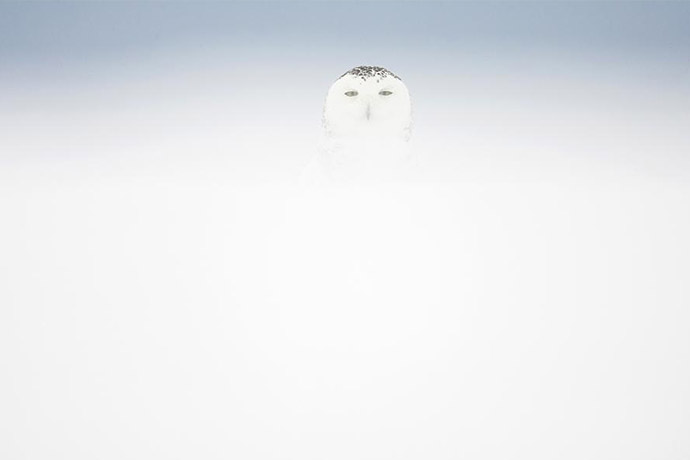
The ghost of the tundra or snowy owl, bathed in soft lights shaded with soft blue and gray, perfectly reflects the poetry of the Nordic countries. One of the largest species of owl, it is the only owl with largely white plumage. It is sometimes also referred to, more infrequently, as the polar owl, white owl and the Arctic owl. They are purer white than predatory mammals like polar bears and Arctic fox.
David Allemand defines himself as a nature photographer. Distraught lover of the Far North and owls, he hunts down life, magnified by the beauty of lights and the aesthetics of shapes, in the great spaces freed from the hand of man. A (beautiful) way of witnessing the fragility of the wild world. Allemand is not a man to be taken in by vertigo. Being a rope access technician by training, he has long used the roofs of buildings and roadside cliffs, before swapping his ropes and carabiners for the camera. Over the past decade, the ex-rope technician has garnered no less than 40 accolades in major international photo competitions — notably, year after year, at the Russian Global Arctic Awards. He has since been drafted as a jury member and even president. A platform that allows him to increase the number of exhibition venues and to bear witness to the global warming which so ardently threatens the polar lands.
David Allemand grew up in the Provence, a geographical region and historical province of southeastern France, and spent a part of his childhood in Verdon, located in the Provence-Alpes-Côte d'Azur region of Southeastern France. Passionate about nature and the great outdoors from a young age, he developed a passion for photography and in 2003, dedicated himself to it completely. The camera became his best expression tool for capturing the ambient poetry of the nature in which he likes to make headway. Allemand isn't specialized in one category more than another, he choose his themes according to the moment or the favorites. He started by photographing landscapes and more particularly animals in their environment. Inspiration came to him on the ground while traveling, nature is his only source of creation. His photos are not just "copy and paste", he often imagines an image before trying to achieve it. He had the opportunity to share long immersions and collaborate with photographer Christophe Sidamon-Pesson. Sidamon-Pesson was definitely a genius and some of his photos impressed Allemand.
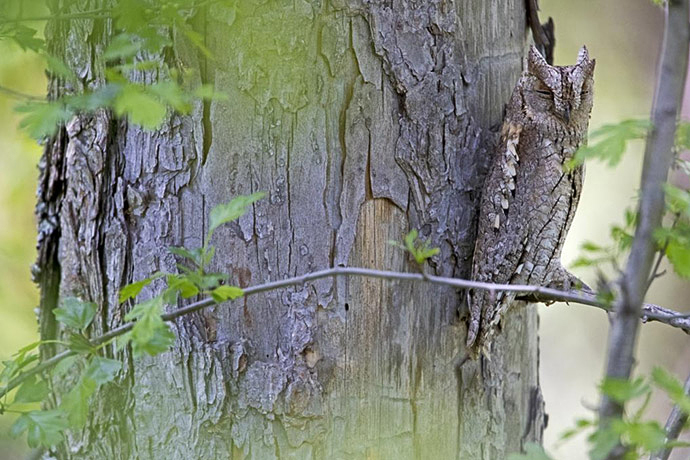
The little vagabond or scops owl — Scops owls are colored in various brownish hues, sometimes with a lighter underside and/or face, which helps to camouflage them against the bark of trees. Some are polymorphic, occurring in a greyish- and a reddish-brown morph. They are small and agile, with both sexes being compact in size and shape. Female scops owls are usually larger than males.
Christophe Sidamon-Pesson (1975-2014) lived in Queyras, in the Hautes-Alpes. He was interested in photography from an early age and got started seriously in the early 90s. This self-taught artist turned professional, specialized in nature photography and collaborated with many nature magazines. In 2002 he published a small book, Queyras (Pêcheur d’images). In November 2014, he tragically passed away in his village of Ceillac in the Hautes Alpes at the age of 39. He had notably published L’Autre versant on the wild nature of this corner of France which he loved so much and which he photographed with delicacy, sensitivity and talent. His photographs, which have been regularly exhibited at national festivals, have won awards in numerous competitions, including the prestigious BBC Wildlife Photographer of the Year in the UK in 2005 and GDT European Wildlife Photographer of the Year in 2008, 2009 and 2010 in Germany, among other things.
Passionate about wild nature, Christophe Sidamon-Pesson felt a deep need to get in touch with himself, whether on the top of the steep mountain ridges, deep in the jungles of Eastern Europe or in the endless space of the Scandinavian taiga. However, to finish his images, he did not skimp on the efforts to which he did not attach much importance. Motionless, at –10°C, he spent hundreds of hours looking out, watching the uncertain arrival of the golden eagle, or whatever the height difference, with a backpack weighing about thirty kilos, he camped on top of a mountain in search of dawn, or, hanging from a rope, in the void of an overheated cliff, he waited religiously for a wallcreeper (Tichodroma muraria).
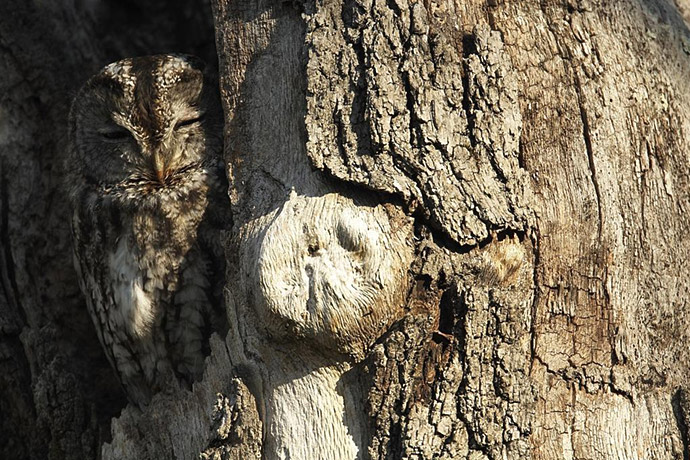
The brown owl or tawny owl — The tawny owl is a stocky, medium-sized owl commonly found in woodlands across much of the Palearctic. This grey morph individual typically nests in a tree hollow.
"Travelling is a wonderful experience to discover new places, faces and differtent customs. It's these unusual encouters that enrich our souls and open our consciences. Travelling is also to immerse ourselves into nature, the encouter with animals, birdsongs, the communion with trees, the caress of the sand, the rolling of the sea If photography is like writing with light, poems about the natural world, then we are happy to be travel photographers. To capture fleeting moments, to guard the short-lived, to believe that we hold back time a little..." — Stéphanie Allemand
Stéphanie Allemand was born in Arcachon, near the Atlantic Ocean crowned by Europe's largest sand dune, where she blossoms between the countryside and the seaside. The attraction to travel to other places led her to the profession of flight attendant which she practiced for years, with a camera always tucked away in her luggage.
Their passes eventually cross, to share the same interest in nature and photography. Their projects are regularly the subject of exhibitions and conferences at photography festivals. His photos are regularly awarded in various international competitions, while she dedicates herself to writing, to tell about their photographic adventures. It is a common passion that is part of four hands. From local work to distant escapades, they produced numerous reports for the international press.
David and Stéphanie Allemand chose the Verdon gorges to photograph the majestic griffon vultures. The duo has been hovering there again since their reintroduction in 1999. It became a story of a successful flight. In 2013, they published their first book Verdon, d'autres Visages, the result of many years spent exploring in the Verdon Regional Natural Park.
"Extinct from Provence more than a century ago, the griffon vulture benefited from a reintroduction program in the Verdon Regional Nature Park. Twelve vultures set off from their aviary on October 16, 1999 in the town of Rougon. Then six releases followed until 2004. Today, around 100 pairs of raptors nest in the gorges. Globally, their population continues to increase, the LPO (Ligue pour la Protection des Oiseaux) counting more than 300 individuals in total on this exceptional site. On July 2, 2015, a vulture was photographed with a chamois carcass above the village of Jaun (FR). The bird had been marked with a colored ring in the Gorges du Verdon in 2014 ... Four days earlier, it was still in Rougon, 320 km due south." — David Allemand
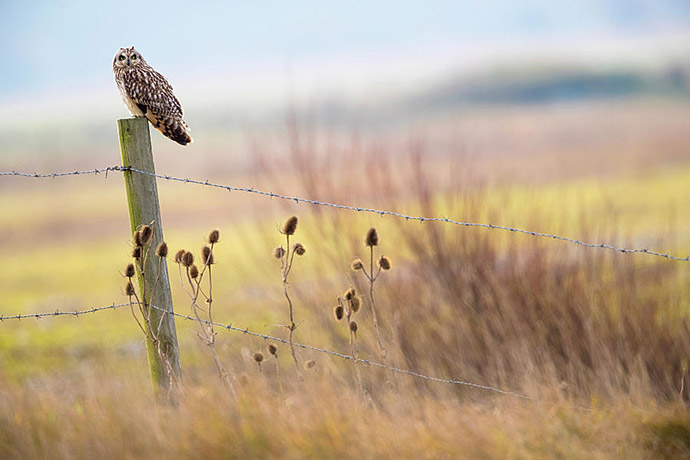
The nomadic short-eared owl — The short-eared owl is a widespread open country and grassland species. These medium-sized owls have tufts of feathers resembling mammalian ears. These 'ear' tufts may or may not be visible.
The day rises in the small village of Rougon, nestled on the side of a cliff in the heart of the Verdon Gorge. The village is perched at an altitude of 930 m, on a spur which also serves as a pass, near the Gorges du Verdon which was formed by the Verdon River, which is named for its turquoise-green colour, one of the location's distinguishing characteristics. It is here, in this Regional Natural Park, that the stronghold of the griffon vulture is located. It is truly spectacular to watch this giant of the sky soar over this Provencal Grand Canyon. David and Stéphanie Allemand's exploration begins with a rocky promontory at the ruins of the fortified castle, perched on a vertiginous ridge overlooking the entrance to the Gorges du Verdon. But the best view is higher up, at the Crêperie de Rougon. The site is opposite the aviaries created for the reintroduction of these scavenging raptors. Twice a week, the League for the Protection of Birds deposits carcasses made available to them by breeders. They leave this protected area and reach the edge of the cliff, still waiting for the flight of the vultures, sitting at the edge of the vertiginous cliffs. Below, hundreds of vultures are waiting for the weather conditions to be favorable for takeoff. When the wind blows forcefully at dawn, the scavengers early. The view of the gorges, carved by the water of the Verdon, is extraordinary. Red-billed crow, raven, wallcreepers, golden eagle, griffon and cinereous vulture… so many fascinating creatures inhabit this very special area! Take off is the most interesting moment for their shots but it's not easy to immortalize this fleeting moment.
A first griffon vulture finally launches into the void without warning ... The rest of the colony soon follows him. Scavengers spin in the air drawing circles. Some go down in spirals and then come back up, playing with the wind. Sometimes solo, others as a couple but also in large groups. Because these birds are above all gregarious. Most of the vultures having flown, their hope rests now with one individual posted on the cliff at the same height as their target. As his friends hover in the sky, wait for him. Look at the sky. Hesitates. Allemand keeps his eyes on the viewfinder, every second can be good. The minutes pass, endless. Then, suddenly, the beast spreads its wings and defies the abyss. 3-2-1… Take off! The icing on the cake, the raptor carries in its tracks a superb arabesque of snow.
Overwhelmed by this splendid observation, the Allemand couple admires the lightness and the grace of these celestial dancers. This fairytale spectacle is completely silent except for the whistling of their gigantic wings flirting with the wind. The magic of these moments took them back to their childhood, where they discovered everything with wonder. At the top of the cliffs, they also travel through time ...
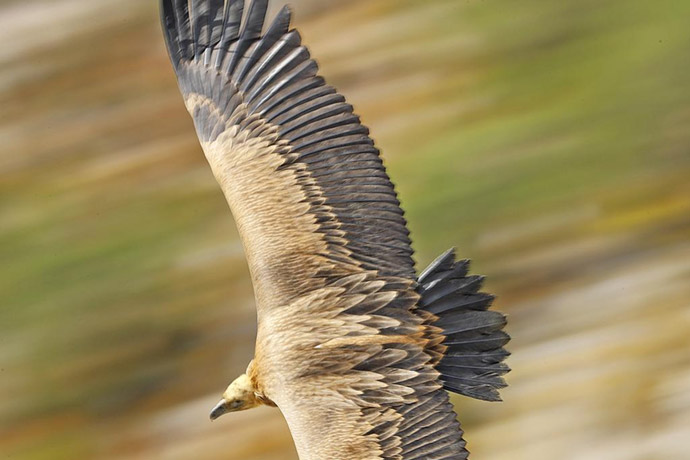
Vultures are the largest birds in Europe. Griffon vultures, true virtuosos of the wind, accompany Allemand during a privileged photographic moment.
It took about ten years of photographic work through Europe to bring the nocturnes to light. Their long-term project reached a peak in 2017. They finally sealed their encounters with the thirteen species of European owls in a beautiful book of more than 260 pages, appropriately titled Owls. Owls reveals the hidden and mysterious world of these charismatic nocturnal birds that fascinated Wildlife photographer David Allemand ... a first in Europe.
The idea of Owls became reality in 2010. One day, while looking at their pictures library, David and Stéphanie Allemand caught themselves stopping at every image of owls completed during their journeys. They found them puzzling and beautiful. The desire to photograph all the species of Europe and to gather them in a beautiful book was born that day. The first meetings fascinated David and Stéphanie and pulled them in an extraordinary adventure, where they were going to discover thirteen species in the family of Strigidaes living in Europe. Strigidae comes from Latin Striga which means 'night bird'. There are 226 species of night birds in the world, 13 of which can be found in Europe. So they went on a long journey to search and observe the European Strigiformes in a close bond with nature in order to finalize this project: the snowy owl — ghost of the tundra, the great grey owl — spirit of the taiga, the Ural owl, the Northern hawk-owl, the Eurasian eagle-owl, the long-eared owl, the Eurasian scops owl, the tawny owl, the short-eared owl, the barn owl, the little owl, the Tengmalm's owl and the Eurasian pygmy owl. They explored several countries to meet them, going through seasons and landscapes as different as the seaside, the French mountains, the primary forests of Scandinavia and the desert plains in the heart of Spain.
These fantastic, intriguing birds love to hide, to disappear. The night is their kingdom. It is therefore fantastic to be able to discover these mysterious birds in broad daylight in the fairytale surroundings of the Natural Park Des Ecrins.
For at least a decade Allemand has been ingenious in 'painting' their portrait. He has devoted five years to it, from north to south, east to west of the continent. Supporting on solid biological knowledge and a vast network of scientists and naturalists, he follows them to their limits. David Allemand observed these birds very meticulously and with a lot of patience. In the Natural Park Des Ecrins he had the opportunity to discover the birds in their own territory. There are open spaces with beautiful light, a great place to photograph these birds with various light incidence (in the morning or in the evening). David Allemand has a leitmotif: for this project, he has never used flash and does not like infrared barriers, which allow you to photograph an animal without even being present. His favorite techniques are spotting, patience and mastery of incompressible frustration (broken down camera, tripod and flying subjects …). One of his favorite images, showing a stirring dipper in the Verdon waterfalls, with an aquatic plume frozen by a long exposure, required days of searching and testing.
It is very important to be able to observe the birds properly. David Allemand is also a scout, a researcher. His voyage of discovery already starts at the foot of the trees. The birds throw balls from their nests called pelotte. A pellet, in ornithology, is the mass of undigested parts of a bird's food. They give information about what the bird has eaten. For example, a tree is used to store food or as a resting place for adult animals outside the nesting period. Some owls even come out of the forest to hunt, daring to attack a predator bigger than them.
Being a fan of manual mode and burst photography, Allemand likes to freeze the subject in flight (at the 1000th or 2000th of a second) after having succeeded in anticipating its movements. In his photos, very little retouched, birds and mammals willingly star with landscapes, forests and trees. The movement, the composition plays a great role there. "I attach great importance to the graphism and the artistic side of the image, using techniques such as movement panning, isolating the subject from the background or long exposure," says Allemand.
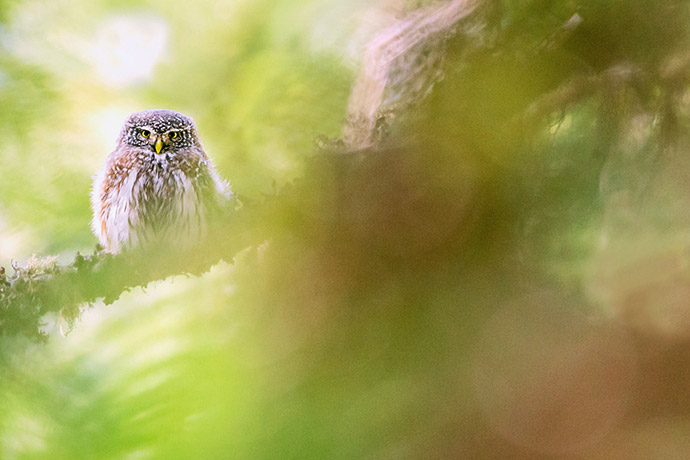
Pygmy owl — This owl is tiny, but it’s a ferocious hunter. They are mostly dark brown and white, with long tails, smoothly rounded heads, and piercing yellow eyes.
David Allemand is also a naturalist, strongly inspired by Charles Darwin's book The Origin of Species. In addition to being an 'image hunter', Allemand is also a protector of nature. When he takes pictures he cannot work all day long because the light changes constantly during the day, and the birds also have specific attitudes, for example in the spring when feeding. When he's out in the field, he tries to spend as much time as possible taking the best photos.
The owl's habitat is fairly well known through research, a wealth of information shared by park rangers and each tree indexed in GPS points. The conservation of the owl species is not incompatible with the exploitation of the forest (logging), although the harvest of timber from the owl's habitat is, perhaps, the greatest threat to this species. It only has to be done at the right times and the nests and the hollow trees have to be preserved, making sure that they are surrounded by an island of trees.
David Allemand has made an astonishing book from his many years of work in which he collected the characteristics of the various European owls. The challenge was to find these nocturnal birds in natural daylight in beautiful surroundings. He wanted to share his fascination with this mythical and fascinating bird species, unknown for centuries, with others. Owls captured in images through photography and the passion of a naturalist photographer.
Camouflage is an art for these owls. The most difficult to photograph was the fearful tawny Owl. And even more so the screech-owl (scops), a species as discreet as it is timid, which migrates in winter to the warmer skies of North Africa. Small miracle, in 2016, after six years of waiting, a couple settled in the nest box installed by David and his wife Stéphanie in their garden! You cannot say owls are nocturnal. The Allemand couple has succeeded in making all their portraits by day, in the most beautiful settings and lights. It's all about knowing. The barn owl, which evolves exclusively at night in France and Switzerland, is sometimes a day hunter in Great Britain. As for the northern territories, they unfold summers that obliterate even the very existence of night, forcing the birds to sunbathe.
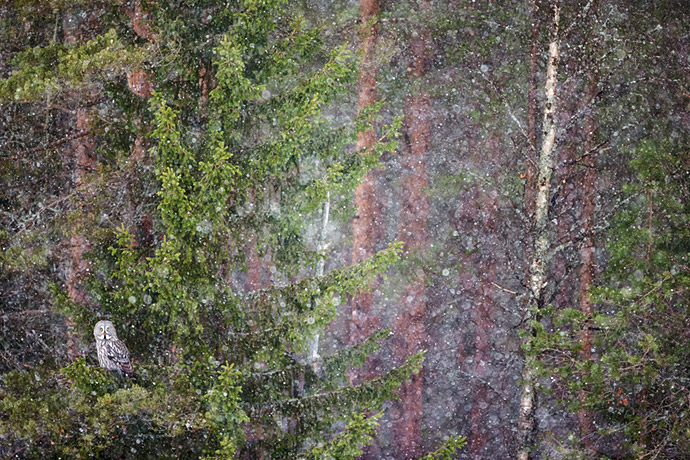
Great grey owl is a very large owl, documented as the world's largest species of owl by length. Adults have a large rounded head with a grey face and yellow eyes with darker circles around them. This owl does not have ear tufts and has the largest facial disc of any raptor.
"Owls, this name suits them so well, short and mysterious similar to their night calls. To hear their mystic songs, to be aware of their presence, to perceive a shadow, a movement, a sign from them. All these are the premises of a future delight as well as a passionate quest. Stubbornly, fervently, we wait for them." — David Allemand
They have traveled through many countries but remain particularly sensitive to the soft and magical lights of the Nordic countries where they stay very often. Stéphanie and David Allemand are supported in their projects by various partners such as Canon France, Patagonia, Manfrotto and Tragopan. They are also photographic guides in Europe, the Arctic and Africa. By showing their photographic work, with their artistic approach to nature, they hope to sensitize awareness and awaken consciousness for the preservation and protection of our planet.
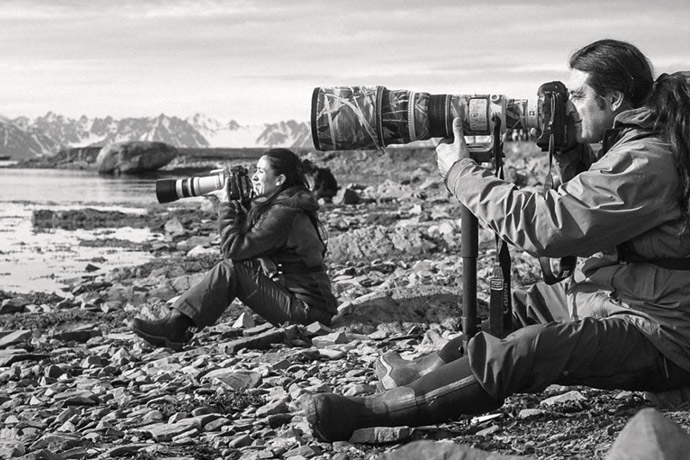
David Allemand is particularly fond of an image taken in the Verdon Regional Natural Park of a White-throated dipper fighting against the current above a waterfall. A freeze frame to freeze a relatively long pause time to immortalize this scene of a bird in perpetual motion. Spending a lot of time in the field and less in front of the computer, getting up early and contemplating nature, you will inevitably have beautiful surprises. Technique is fundamental, important, but being in the field is even more so. He thinks you learn the technique by practicing. He is of course a self-taught person after all.
If you are intrigued by these fine nature people, check out this short film: Une Histoire de Regards - Short film
Stay amazed!
All images courtesy of the artist. All images featured © David and Stéphanie Allemand
Special thanks to Myriam Claes.
Related stories in Woodland Magazine:
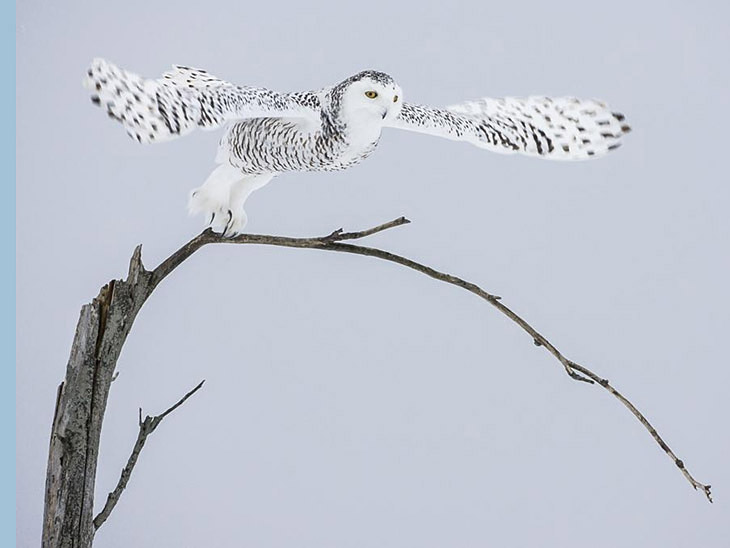

1 comment
Hello Joël,
Thank you very much for your email.
We are very glad that you appreciate our book and our photographic work. It is very touching to read the journal you wrote about us and to imagine the energy and the time you spend to put our work in honor. Thank you so much for that...
Of course, it is with pleasure that we are going to share your blog amongst our contacts on our website, in the "news" section, in our newsletter...)
You can also put our e-mail into your mailing list, thanks.
We hope to read from you soon,
Have a good day,
All the best,
Stéphanie and David Allemand